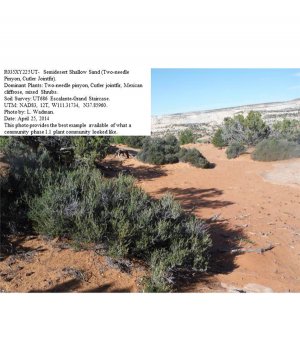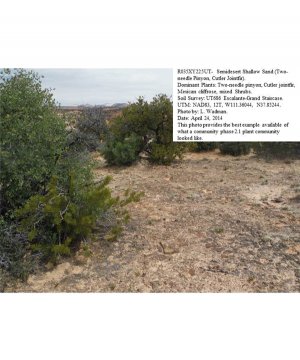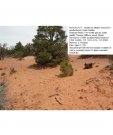Semidesert Shallow Sand (Cutler''s Jointfir)
Scenario model
Current ecosystem state
Select a state
Management practices/drivers
Select a transition or restoration pathway
- Transition T1A More details
-
No transition or restoration pathway between the selected states has been described
Target ecosystem state
Select a state
Description
This Reference State describes the historic plant communities and natural ecological dynamics of the Semidesert Shallow Sand, Cutler jointfir site. It includes those biotic communities that became established on this ecological site when all successional sequences are completed under natural climatic conditions; natural disturbances are inherent in its development.
This state is dominated by an overstory of two-needle pinyon with some Utah juniper, and a mixture of shrubs with Cutler jointfir, Mexican cliffrose and singleleaf ash occurring most commonly. A wide variety of other shrubs are also found in both community phases on this site. Perennial grasses including Indian ricegrass and Sandhill muhly, may or may not be present depending on spot-fire occurrence, soil development and available moisture. The primary disturbance mechanisms are weather fluctuations, runoff moisture and spot fires.
Two distinct phases of this reference community have been characterized in this report, the first and most prominent, is the Shrub Phase. This phase of the ecological site is characterized by an overstory of old two-needle pinyon with some Utah juniper also present. A shrub layer dominates the understory with Cutler jointfir, Mexican cliffrose, singleleaf ash and a wide variety of other shrubs commonly found. Herbaceous species make up less than 10 percent of the understory.
The Herbaceous Phase is characterized somewhat less shrub production in the understory while the perennial grasses and other herbaceous species are more prominent in appearance.
Terminology:
Reference State: Community phases disturbed by spot-fire occurrence, soil depth, run-on moisture and climate fluctuations.
Indicators: A site dominated by Cutler jointfir and various other shrub species. Indian ricegrass, Sandhill muhly and other herbaceous species may also be present.
Feedbacks: Extended drought resulting in a reduction of native perennial plant vigor. Normal fluctuations in weather allowing for the maintenance of both shrubs and perennial grasses.
At-risk Community Phase: All communities are at risk when nutrients are available for invasive plants to establish. Plant community 1.1 is especially at risk due to limited production and cover of understory grasses.
Trigger: Introduction of invasive plants to fill available niches.
Submodel
Description
This Current Potential State is dominated by an overstory of two-needle pinyon with some Utah juniper, and a mixture of shrubs with Cutler jointfir, Mexican cliffrose and singleleaf ash occurring most commonly. A wide variety of other shrubs are also found in both community phases on this site. Perennial grasses and forbs may not be present on the site. Invasive annuals such as cheatgrass, Russian thistle and redstemed storksbill may be present in small amounts where a seed source is available. Bare ground percent can range as high as 85 percent and may be stable or loose sand grains depending on cryptogamic crusting percent. Primary disturbance mechanisms are weather fluctuations, runoff moisture and spot fire occurrence.
Terminology:
Reference State: Community phases disturbed by spot-fire occurrence, soil depth, run-on moisture and precipitation fluctuations.
Indicators: A site dominated by Cutler jointfir and various other shrub species. Indian ricegrass, sandhill muhly and other herbaceous species are not typically present.
Feedbacks: Extended drought resulting in a reduction of native perennial plant vigor. Normal fluctuations in weather allowing for the maintenance of both shrubs and perennial grasses.
At-risk Community Phase: All communities are at risk when nutrients are available for invasive plants to establish.
Trigger: Introduction of invasive plants to fill available niches.
Submodel
Mechanism
This transitional pathway describes the affects of long term drought, continued heavy wildlife browsing and the establishment of invasive species such as cheatgrass or Russian thistle. A threshold is crossed when invasive and/or non-native species become established.
Model keys
Briefcase
Add ecological sites and Major Land Resource Areas to your briefcase by clicking on the briefcase (![]() ) icon wherever it occurs. Drag and drop items to reorder. Cookies are used to store briefcase items between browsing sessions. Because of this, the number of items that can be added to your briefcase is limited, and briefcase items added on one device and browser cannot be accessed from another device or browser. Users who do not wish to place cookies on their devices should not use the briefcase tool. Briefcase cookies serve no other purpose than described here and are deleted whenever browsing history is cleared.
) icon wherever it occurs. Drag and drop items to reorder. Cookies are used to store briefcase items between browsing sessions. Because of this, the number of items that can be added to your briefcase is limited, and briefcase items added on one device and browser cannot be accessed from another device or browser. Users who do not wish to place cookies on their devices should not use the briefcase tool. Briefcase cookies serve no other purpose than described here and are deleted whenever browsing history is cleared.
Ecological sites
Major Land Resource Areas
The Ecosystem Dynamics Interpretive Tool is an information system framework developed by the USDA-ARS Jornada Experimental Range, USDA Natural Resources Conservation Service, and New Mexico State University.







